Winter
Wildlife in Tuolumne Meadows
Yosemite National Park
WINTER
2004/2005
Tracey
Wiese and Bruce Carter
Tuolumne Winter Rangers, Yosemite National Park
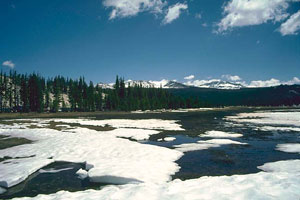 |
| After a long winter, spring comes to Tuolumne Meadows. |
From November to May we work as the rangers in Tuolulmne meadows in Yosemite National Park. When snow closes the road it's just us, an occasional cross-country skier or snowshoer and 100 square miles of white silence. The birds and animals who live here are often happy to see the tourists gone. The following wildlife observations were made between October 17, 2004 and May 6, 2005. All of the observations were made in the Tuolumne Meadows area and nearby environs by Tracey Wiese and Bruce Carter unless otherwise noted. They are listed in a general order of the most commonly seen to the least commonly seen residents and visitors.
MAMMALS
Seeing wildlife is always a highlight of being in the backcountry. The snows of winter quickly indicate all of the animal neighbors that are always present but whom we rarely see. On October 18, skiing on the first snowfall of the season, we saw the tracks of coyote, pine marten, squirrel, rabbit, mouse, and bear. I doubt that these animals changed their travel pattern overnight; it’s just that we could suddenly see their tracks in the snow that indicated their presence. And with continuous snow coverage well into May we had the opportunity to see their tracks all winter long.
CHICKAREE (Tamiasciurus douglasii) A very common winter resident. We heard and saw these little squirrels regularly around our cabin and throughout the forested areas where we skied.
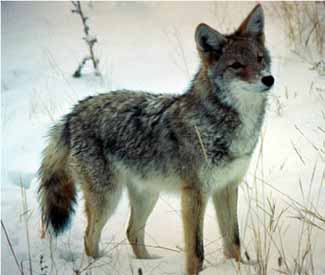 |
| Coyote are found in the Sierra at all elevations and at all times of
the year. NPS Photo |
COYOTE (Canis latrans) Coyote tracks were very common throughout the winter and we had sightings of coyotes every month of the winter. We saw them up Lyell Canyon, several times out in the meadows at Tuolumne, along the Tioga Road on both sides of Tioga Pass and on the apron of Lembert Dome. The coyotes seemed to be subsisting primarily on Juniper berries. Their scat seemed to contain nothing but juniper berries. Many times during the deepest snows we would see their fresh tracks on the shoulder of Lembert Dome, directly behind our cabin, in among the big juniper trees where they were digging in the snow to get berries that had fallen off. Their tracks followed the same pattern each time and we got so that we would know where to look for their tracks.
Later in the season when the snow was firm and easy for a coyote to walk on we would see their tracks far and wide. Lembert Dome still seemed to be a popular place and more than once we heard the chorus of coyotes howling just behind our cabin up on the road or on the shoulder of the dome.
One of our more interesting sightings was not of a coyote itself, but its telltale tracks on the edge of the ice on the Tuolumne River. The tracks were quite fresh and made in the tiny skiff of snow on the ice. The river had very few openings at that time (November 24) and at this particular spot it was open in a shallow backwater where tiny, sardine-sized fish were darting about. The coyote had walked back and forth on the thin ice, even breaking off a small ledge of ice, obviously looking at those darting fish. We saw no signs of the coyote entering the water or ever getting a fish, and perhaps it was just the movement of the fish that caught its attention. In any case, it is easy to speculate that a fish dinner would have tasted pretty good after nothing but juniper berries.
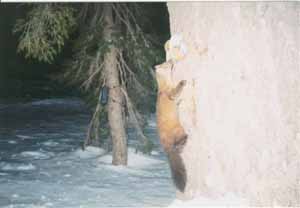 |
| Pine Marten
(Martes Americana) at bait station. CSERC photo |
PINE MARTEN (Martes americana) The tracks of Pine Marten were common among the trees everywhere we went. We had several sightings over the winter, all in the Ranger Camp area, mostly right from our cabin. The marten that frequented the Ranger Camp had a pretty regular pattern that it traveled as it checked around the buildings and dumpsters. We watched one crawl all around a half buried dumpster one morning, one that in previous years it could get into via a hole, but it found no entrance and scampered off.
Our front deck was on the regular travel pattern and a number of times we spotted a marten on the deck. Our doors have glass to within 6” of the deck and that made it easy to get a good look at the marten as it nosed around on our deck. One morning a marten boldly sniffed our doors for some time as we sat eating breakfast. Knowing that martens have a penchant for sweets, I can only guess that it was the smell of cinnamon coffee cake that was drawing it in.
We had a packrat living in our woodshed this winter and one morning the woodshed door was left open for a short while as we were going back and forth to the cabin. We were both inside when we spotted a pine marten going past our cabin and we quietly watched it from various windows as it rounded the corner and saw the open door. The door being open was out of the ordinary and the marten slowed its pace and crept slowly up to the door. It peeked around the corner of the doorway and then slowly went inside. We were silently hoping that the marten would make a meal out of that packrat so that we would be free of the rat and the mess it constantly made inside the woodshed. Unfortunately the marten didn’t get a meal that morning, and several weeks later we purposely left the door open again for awhile and watched the same scene all over again. The packrat seemed to survive the entire winter and the marten must have found something else to eat, though it must have been frustrating to catch the scent of that packrat every time it loped by.
BLACK BEAR (Ursus americanus) The early snowfall this season caught at least one black bear who was not quite ready for hibernation. We saw bear tracks on Oct. 18 right after the first snowfall and continued to see them off and on for more than a month. The next day, Oct. 19 a bear wandered through the cabin area during the couple of hours that we were over at the Wilderness Permit building putting up the shutters. We returned for lunch and saw tracks going from cabin to cabin, including standing on the porch of the cabin next door. We quickly checked all the cabins in the area and fortunately, none had been broken into.
It was a few weeks until we spotted bear tracks again. It was mid-November and after dark when I was chatting with some folks in the ski hut. I caught the sight of movement out of the corner of my eye through the window and swung open the door to almost hit a bear on the backside. It definitely surprised me more than the bear who barely took notice of me as I yelled and waved my arms at it. A couple hours later at our cabin, a half mile away from the ski hut, we both heard a noise, looked at each other and bolted for both of our entrance doors. Sure enough, the same bear was just making the rounds and checking the cabins, including ours. This time it ran a few steps at the sound of our yelling but really seemed quite undisturbed by us. A few days later we skied to Snow Flat Cabin and back and followed the tracks of a bear that had checked out every garbage can and recycle can all the way to Tenaya Lake. Unfortunately it found rewards at some of the unsecured cans and we spent most of the next day checking every can that we could think of, cleaning up the mess the bear left behind, and securing the cans. Several days later (Nov 11) we saw bear tracks up Lyell Canyon which were the last ones of the season.
On April 3 we spotted the first bear tracks of the spring as we skied up the Tioga Road in a snowstorm. The tracks cut across the road near Little Blue Slide and disappeared up the hill. By mid-April we were seeing bear tracks at numerous locations throughout the high country, including up at nearly 11,000 feet. Some of the tracks we saw seemed to wander around in circles, others were clearly going somewhere direct such as one set of tracks that we saw going up and over a very steep ridge on the west side of Post Peak Pass.
LONG TAILED WEASEL (Mustela frenata) Although we only saw one weasel this winter their tracks were fairly common in the open meadows and along the Tioga Road where they dart around and tunnel under the snow.
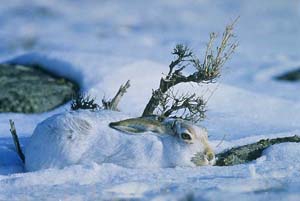 |
| White-tailed Jackrabbit Photo: Rod Planck |
WHITE-TAILED JACKRABBIT(Lepus townsendii)Tracks of this rabbit were common all winter and at all elevations, though noticeably not as common as the last two years. It still surprises me to be up at elevations of 11,000 feet or higher and see tracks of a rabbit who has been subsisting on the bits of brush that stick out of the snow on the windswept slopes. We had just one actual sighting of this jackrabbit, just up the road from our cabin as it darted across the snow covered road.
WHITE-FOOTED
DEER MOUSE(Peromyscus maniculatus)
VOLE
(Microtus montanus)
SHREW(Sorex)
Tracks of mice, voles and shrews were regularly seen in the snow around the cabins and around the meadows and the road where they appear to run back and forth from one hiding spot to the next. It is always perplexing to see the tracks of one of these tiny rodents strike off across an open meadow, for some reason, with no cover in sight.
We had one unusual mouse encounter when, in late October, we were skiing through Dana Meadows and suddenly we looked up and saw a little mouse running down the slope toward us. Puzzled, we stopped and watched it run at us then climb on to Bruce’s ski. It climbed on his boot, chewed on his boot lace and ran around to the back of his ski, all while we watched and laughed. Finally we had to ski off, the mouse hopped off the back of the ski and the last we saw of it was running down the ski track in the direction from which we had come.
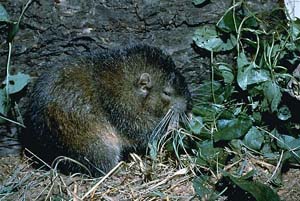 |
Mountain
Beaver: A little known Sierra mammal. Found near streams but not
related to the Beaver. |
MOUNTAIN BEAVER (Aplodontia rufa) A mountain beaver was spotted running around on the surface of the snow on March 28 in Tuolumne Meadows by a couple of skiers. They had no idea what it was but described the little animal and then showed the digital photo that they had taken – definitely a mountain beaver. We have not seen the caches and nests of mountain beaver that we did last spring, but then, the weather and snow conditions are very different from last year at this time.
PORCUPINE (Erethizon dorsatum) We saw porcupine tracks only a couple of times this winter, once right next to the Wilderness Permit building and another time on the road near Pothole Dome.
BUSHY-TAILED WOOD RAT (Neotoma spp.) As mentioned above we had a packrat living in our woodshed this winter. We never did see it but its presence was known by the debris that it carried in and stored all over our firewood.
CHIPMUNK (Tamias) The last chipmunk that we saw in the fall was on Nov. 4 along Dingley Creek in Tuolumne Meadows. We did not see a chipmunk, or any tracks of one until May 4 when one was spotted in front of the Ranger Station.
BELDING GROUND SQUIRREL (Spermophilus beldingi) The first sign of ground squirrels was on May 4. We had been watching for them and had not spotted any holes or any squirrels until this time, when they suddenly started popping up in the meadows.
YELLOW-BELLIED MARMOT (Marmota flaviventris) We spotted the first marmot hole of the spring on April 10 in Lyell Canyon. After that date it seemed as though we started seeing their dirty entrance holes all over the place. Their tracks indicate that they don’t travel very far from the safety of those holes, at least initially.
BOBCAT ( Lynx rufus) We saw no sign of bobcats this entire winter season. It is included here only to point out its absence, since we regularly saw signs of bobcats the last two winters.
Continued Part 2: Birds and Insects
Our Founder Questions? Go to About Our New Site |
Masthead
Photo from: |